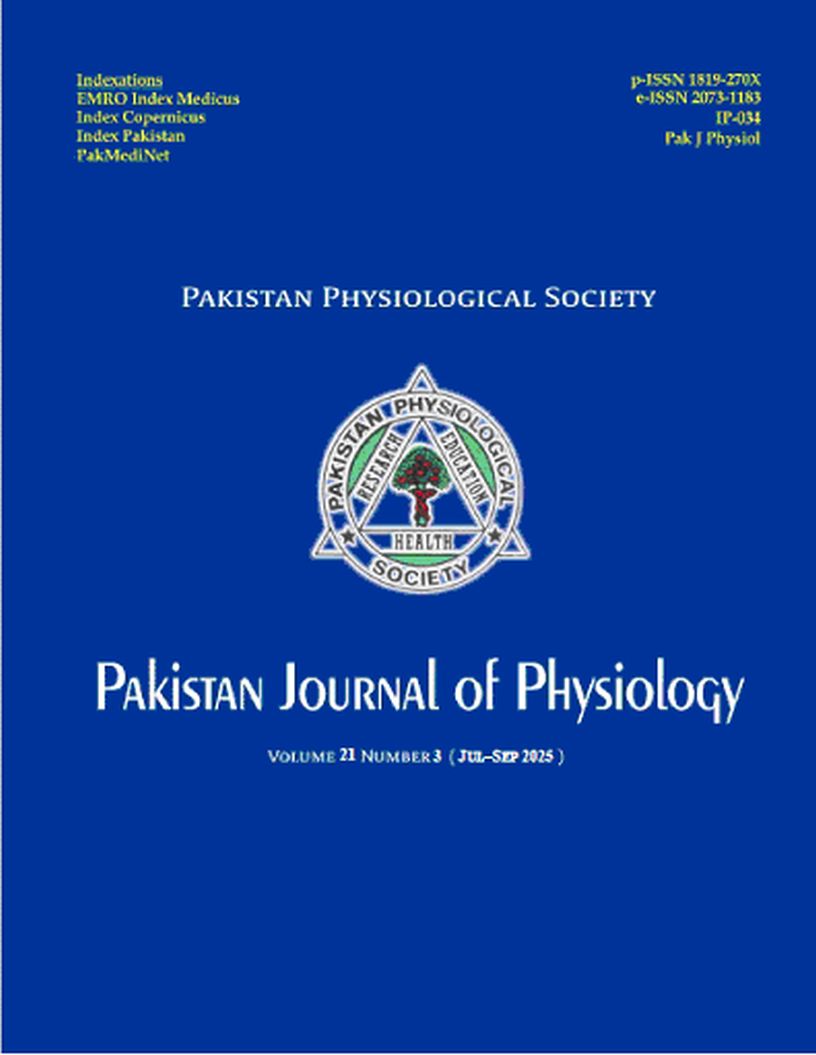EFFECTS OF ALPHA LIPOIC ACID ON OXIDATIVE STRESS AND CONTRACTILE FUNCTIONS OF FAST MUSCLES IN TYPE 2 DIABETIC MALE SPRAGUE DAWLEY RATS
DOI:
https://doi.org/10.69656/pjp.v21i3.1765Keywords:
Alpha lipoic acid, Contractile function, Malondialdehyde, Muscle, Type 2 diabetes mellitusAbstract
Background: Metabolic derangements and oxidative stress due to Type 2 Diabetes Mellitus (T2DM) has deleterious effects on skeletal muscle contractile functions. This study aimed to see the effects of alpha lipoic acid (ALA) on oxidative stress and contractile functions of fast muscles in type 2 diabetic male Sprague Dawley rats. Methods: This quasi experimental study was conducted at Department of Physiology, CMH Multan Institute of Medical Sciences, Multan from Sep 2022 to Feb 2023. Ninety adult Sprague-Dawley rats were randomly divided into 3 equal groups (n=30). Group A (control group) Group B (Diabetic group) and Group C (ALA-treated group). Diabetes was induced in group B and C by injecting Streptozocin (35 mg/Kg body weight) intraperitoneally in the lower-right quadrant of the abdomen after 2 weeks. After 4 weeks, extensor digitorum longus (EDL) muscles were dissected and contractile functions assessed through iWorx data acquisition unit. Serum Malondialdehyde (MDA) and plasma glucose levels were estimated through cardiac blood sampling. Results: ALA group showed improvement in maximum fused tetanic tension, fatigue and recovery from fatigue protocol as compare to the diabetic group. No significant difference among all the groups was found in maximum tension and time to relax to peak twitch tension. Serum MDA levels were found significantly deceased in ALA group as compared to the diabetic group. Conclusion: ALA supplementation decreases oxidative stress which improves contractile force and delays fatigue in fast muscles of diabetic rats.
Pak J Physiol 2025;21(3):30–3, DOI: https://doi.org/10.69656/pjp.v21i3.1765
Downloads
References
Sun H, Saeedi P, Karuranga S, Pinkepank M, Ogurtsova K, Duncan BB, et al. IDF Diabetes Atlas: Global, regional and country-level diabetes prevalence estimates for 2021 and projections for 2045. Diabetes Res Clin Practice 2022;183:109119.
Sawano S, Mizunoya W. History and development of staining methods for skeletal muscle fiber types. Histol Histopathol 2022;37(6):493–503.
Katz A. The role of glycogen phosphorylase in glycogen biogenesis in skeletal muscle after exercise. Sports Med Health Sci 2023;5(1):29–33.
Den Hartogh DJ, Vlavcheski F, Giacca A, Tsiani E. Attenuation of free fatty acid (FFA)-induced skeletal muscle cell insulin resistance by resveratrol is linked to activation of AMPK and inhibition of mTOR and p70 S6K. Int J Mol Sci 2020;21(14):4900.
Koska J, Saremi A, Howell S, Bahn G, De Courten B, Ginsberg H, et al. Advanced glycation end products, oxidation products, and incident cardiovascular events in patients with type 2 diabetes. Diabetes care 2018;41(3):570–6.
Ambrosi N, Guerrieri D, Caro F, Sanchez F, Haeublein G, Casadei D, et al. Alpha lipoic acid: a therapeutic strategy that tend to limit the action of free radicals in transplantation. Int J Mol Sci 2018;19(1):102.
Rasul A, Latif N, Ali S, Ashfaq M, Mubarak S, Rehman I. Taurine supplementation normalizes skeletal muscle functions in type 2 diabetes rats. Pak Armed Forces Med J 2020;70(1):224–9.
Abdelkader NF, El-Batal AI, Amin YM, Hawas AM, Hassan SHM, Eid NI. Neuroprotective effect of gold nanoparticles and alpha-lipoic acid mixture against radiation-induced brain damage in rats. Int J Mol Sci 2022;23(17):9640.
Warmington S, Tolan R, McBennett S. Functional and histological characteristics of skeletal muscle and the effects of leptin in the genetically obese (ob/ob) mouse. Int J Obes Relat Metab Disord 2000;24(8):104050.
Ko IG, Jin JJ, Hwang L, Kim SH, Kim CJ, Won KY, et al. Adenosine A2A receptor agonist polydeoxyribonucleotide alleviates interstitial cystitis-induced voiding dysfunction by suppressing inflammation and apoptosis in rats. J Inflamm Res 2021:367–78.
Wang F, Wang X, Liu Y, Zhang Z. Effects of exercise?induced ROS on the pathophysiological functions of skeletal muscle. Oxid Med Cell Longev 2021;2021(1):3846122.
Arpag H, Gül M, Aydemir Y, Atilla N, Yi?itcan B, Cakir T, et al. Protective effects of alpha-lipoic acid on methotrexate-induced oxidative lung injury in rats. J Investig Surg 2018;31(2):107–13.
Cao AJ, Yang JH, Mou PL, Wang J. Effect of ?-lipoic acid combined with nerve growth factor on bone metabolism, oxidative stress and nerve conduction function after femoral fracture surgery. J Hainan Med Univ 2017;23(21):72–8.
Makhlouf AMA, Mahmoud AM, Ibrahim RG, Abdul Aziz YS. Effects of vitamin D and simvastatin on inflammatory and oxidative stress markers of high-fat diet-induced obese rats. J Sci Res Med Biol Sci 2021;2(3):39–50.
Zhang T, Zhang D, Zhang Z, Tian J, An J, Zhang W, et al. Alpha-lipoic acid activates AMPK to protect against oxidative stress and apoptosis in rats with diabetic peripheral neuropathy. Hormones (Athens) 2023;22(1):95–105.
Reis NG, Assis AP, Lautherbach N, Gonçalves DA, Silveira WA, Morgan HJN, et al. Maternal vitamin D deficiency affects the morphology and function of glycolytic muscle in adult offspring rats. J Cachexia Sarcopenia Muscle 2022;13(4):2175–87.
Eshima H. Influence of obesity and type 2 diabetes on calcium handling by skeletal muscle: spotlight on the sarcoplasmic reticulum and mitochondria. Front Physiol 2021;12:758316.
Andreeva-Gateva P, Traikov L, Sabit Z, Bakalov D, Tafradjiiska-Hadjiolova R. Antioxidant effect of alpha-lipoic acid in 6-hydroxydopamine unilateral intrastriatal injected rats. Antioxidants (Basel) 2020;9(2):122.
Rafil R, Jusadi D, Suprayudi MA, Alimuddin A, Nuryati S. Evaluation of dietary ?-lipoic acid effect on growth and antioxidative responses of striped catfish (Pangasianodon hypophthalmus). AACL Bioflux 2022;15(3):1453–60.
Hong OK, Son JW, Kwon HS, Lee SS, Kim SR, Yoo SJ. Alpha-lipoic acid preserves skeletal muscle mass in type 2 diabetic OLETF rats. Nutr Metab (Lond) 2018;15:66.
Downloads
Published
How to Cite
Issue
Section
License
Copyright (c) 2025 Barkat ullah Khan, Ayesha Irfan, Amjad Ali, Ikram Ullah khan , Faiza Ikram , Sidra Arshad

This work is licensed under a Creative Commons Attribution-NoDerivatives 4.0 International License.
The author(s) retain the copyrights and allow their publication in Pakistan Journal of Physiology, Pak J Physiol, PJP to be FREE for research and academic purposes. It can be downloaded and stored, printed, presented, projected, cited and quoted with full reference of, and acknowledgement to the author(s) and the PJP. The contents are published with an international CC-BY-ND-4.0 License.











